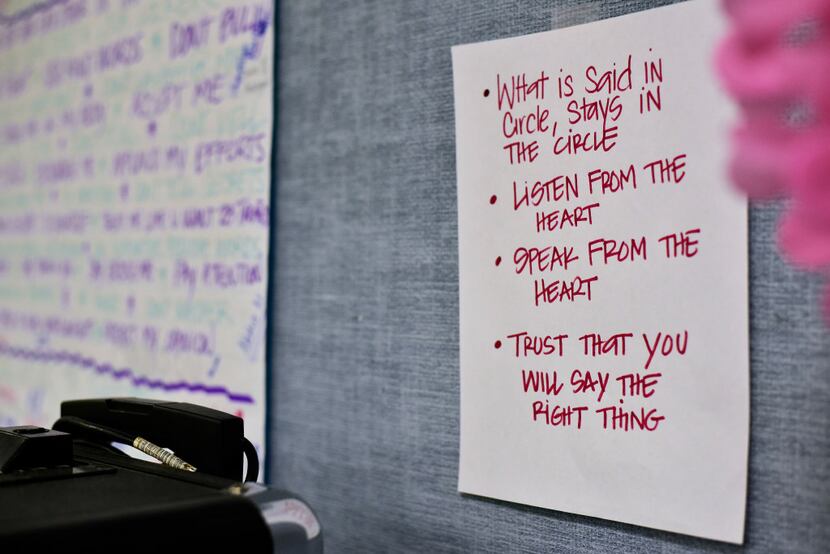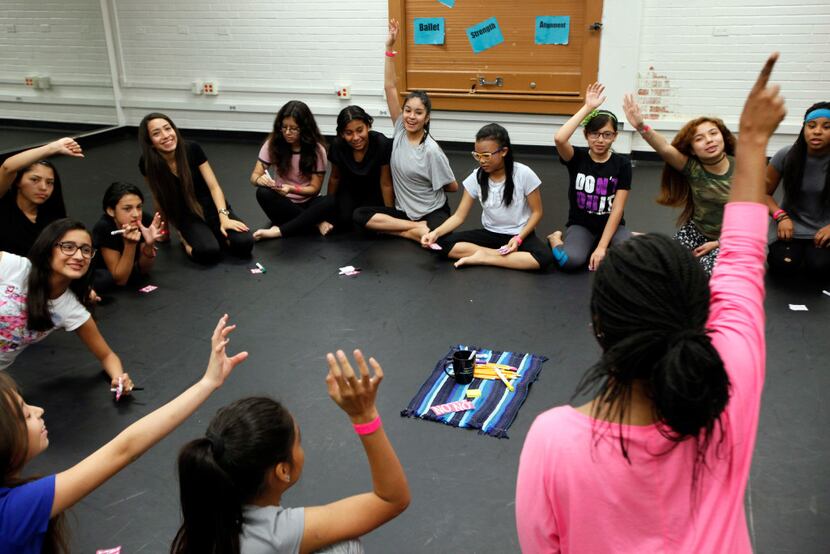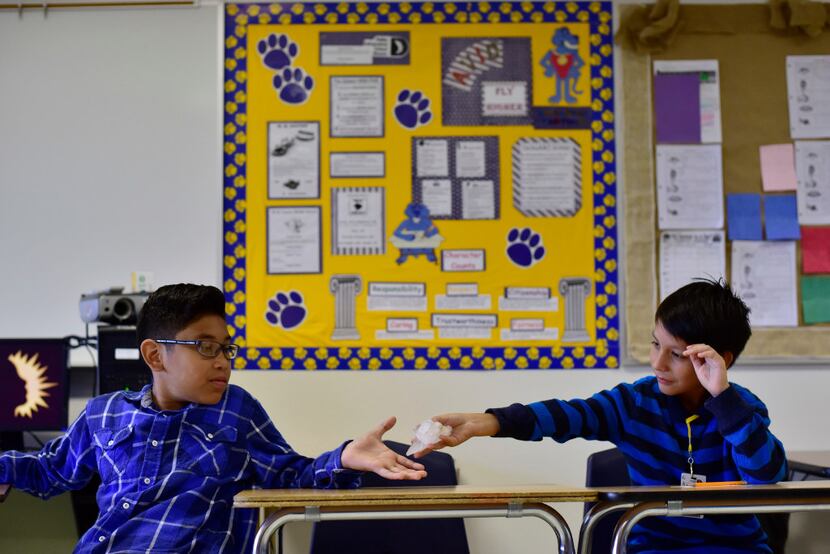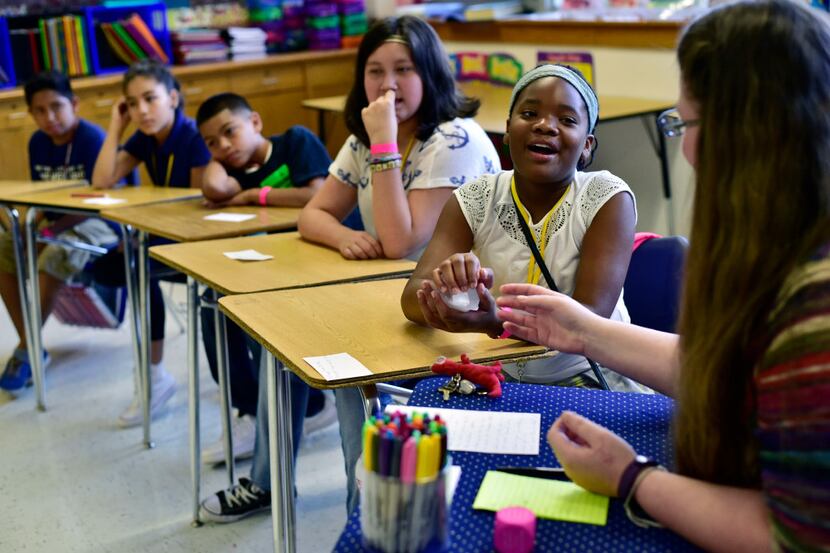Sarah Hoffman’s sixth-grade students sit in a circle.
“If you could change anything about your parents, what would it be?” the social studies teacher asks. The responses start out silly, but then get deep:
“I wish my parents would stop fighting.”
“I wish my mom didn’t worry so much.”
“I wish my dad stopped drinking beer.”
The dialogue circle at Gaston Middle School is a key part of Dallas ISD’s restorative practices program, an effort to prevent disciplinary issues in classrooms by fostering relationships between teachers and students. Last year, the district started the initiative at four middle schools and two elementary schools.
District data says the program is working, and so the pilot has been expanded to 21 schools this year.
“If a student has a relationship with the teacher, a lot of the issues that come across as classroom management and classroom discipline can be solved with the teacher and student,” said Jay Sheets, the district’s restorative discipline coordinator.
Jonathan Clifton, assistant principal at Gaston, agreed.
“We’re putting out fires before they happen,” he said.
The larger goal is to stop the so-called school-to-prison pipeline, in which students — often minority — are disciplined more harshly than their peers. They become more likely to drop out of school and, eventually, referred to juvenile justice facilities or prisons.
The solution starts, Clifton said, with “teachers standing at the door, gauging kids as they come in, trying to find out if this kid is having a major problem today just by saying, ‘Hey, how are you?’”
Sometimes, Clifton said, a child is disruptive because they haven’t had breakfast.
Disciplinary actions at Gaston decreased during the program’s first year.
Out-of-school suspensions fell from 118 during the 2014-15 school year to 82 last year. In-school suspensions dropped from 51 to 41.
Similar results were found across the four district middle schools in the pilot program. There was, on average, a 64 percent reduction for in-school suspensions and a 70 percent reduction in out-of-school suspensions.
Every teacher at Gaston holds a dialogue circle at least once every six weeks that takes up the entire period. They can also call a temporary circle any time there is a classroom disruption. Teachers ask questions and then students — one at a time — have a chance to respond.

Each class creates its own respect agreement, an informal contract that sets the expectations for students and teachers.
In Hoffman’s social studies class, students promised not to talk back, gossip or use their cellphones. Hoffman said she would be nice, patient and positive.
Students didn’t always keep their promises.
Hoffman scolded one girl for pulling out her cellphone. She told one boy to leave the classroom for making fun of his peers.
Hoffman would refer back to the respect agreement whenever there was a violation.
Sometimes students giggled or talked over each other.
“Some people are opening their hearts to you right now. Don’t make them second-guess you,” Hoffman said once when it was getting loud. The students calmed down.
According to Clifton, restorative practices are all about “good old-fashioned relationship building.”
“Anyone can get mad. To the kids, that’s a useless emotion. When teachers feel disappointed, that means there’s a rapport that’s been started,” Clifton said. “For me to disappoint you, it hurts me as well as it hurts you.”
Hoffman said it was hard to get this particular class to really listen during the circle. But she added it was the beginning of the school year and they still had time to set the tone.
“Thirty percent of them still think it’s a funny thing and it can be a funny thing. Everyone deals with hard things differently,” Hoffman said.
Still, some kids hugged her on their way out of the classroom.
This year, she hasn’t had to refer anyone to a counselor. But some conversations got very heavy by end of the last school year.
“I just make sure I have tissues,” she said. She has cried in the circle before.
Some children last year talked about self-harm. One kid said he hated his mom because she spent all her time watching television or on the phone. She never talked to him and told him to go away.
“Usually the class with the worst behavior problems has the most going on in their lives,” Hoffman said.
Clifton observes circles all the time. Once, a teacher asked students what disappoints them.
“I would have said something like — when the Cowboys lose,” Clifton said.
But children started opening up. One boy talked about how he was with his mom when she was robbed at gunpoint and he couldn’t do anything about it. Another student spoke about how he feels responsible for the death of his brother.

In another Gaston circle last year, dance teacher Alexis Brisby called a circle after a student's phone went missing.
She asked children, one by one, how they felt about a violation of the respect agreement: no stealing. The student who took the phone confessed to the class. They forgave her. The teacher cried; the girls cried.
Hoffman and Clifton both said it was difficult to fit the circles into an already packed schedule. But they hoped the return would be a decrease in the amount of time teachers spend dealing with discipline issues during class.
The numbers suggest this may be the case. Cases of classroom disruptions at Gaston fell from 215 in 2014-15 to 199 in the last year.
But more serious offenses seem unaffected. Fighting offenses increased from 113 in 2014-15 to 171 the next year. Non-felony drug offenses continued to hover around the mid-20s.
The hardest part of the process, Clifton said, has been teacher buy-in. Usually, when an incident occurs, many teachers want immediate consequences.
He said many eighth-grade teachers feel students just need the right discipline, and they view restorative justice as a slap on the wrist, a “kumbayah” response.
But he’s always been excited to embrace the change.
“It makes our big school, small. It makes every class a community,” Clifton said.

Restorative practices provide a valuable outlet for some kids.
Jonah Carrabba, now in seventh grade, remembers opening up to his peers in a talking circle last year about being bullied in elementary school.
“Don’t make fun of people. You never know what someone’s been through,” Jonah said.
He also recalled being moved by his peers’ struggles.
“Some students have a really hard life. They crossed the border from Mexico. I haven’t had to face that,” Jonah said.
Yarelli Quintero, in eighth grade, also participated in talking circles last year.
Yarelli told her dance circle about her problems and said “it was a weight off” her shoulders. Sometimes it was awkward — opening up when you don’t really know people, Yarelli said. But sometimes it was fun because she could be loose.
Sheets, the district coordinator for restorative practices, said DISD is almost halfway through a three-year implementation for the program.
In the first year, schools test restorative practices at only one grade level. In the second year, they add a grade level.
This year, seven elementary schools are included in the rollout.
Sheets said he hopes that by teaching the right behavior at a young age, they could prevent issues in middle school.
Andrea Nelson, principal of George W. Carver Creative Arts Learning Center, started implementing restorative practices at the elementary school this year.
“Some kids are in stress mode and flight mode all the time,” she said. “In order for instruction to occur, we have to have kids come back to a place that’s balanced.”
In their talking circles, students talk about what it looks like to be kind and how to act in the “Carver way.”
Restorative practices aren’t the school’s first introduction to social-emotional learning.
Last year, the school started a program called MindUp, which consists of 15 lessons that teach students about the brain and mindfulness.
Nelson remembers overhearing a kindergartner say, “I really gotta think harder because all of my thinking goes to my hippopotamus.” The student meant to say hippocampus, a part of the brain.
Nelson said she has already noticed a decrease in the number of safety violations and an increase in student engagement.

